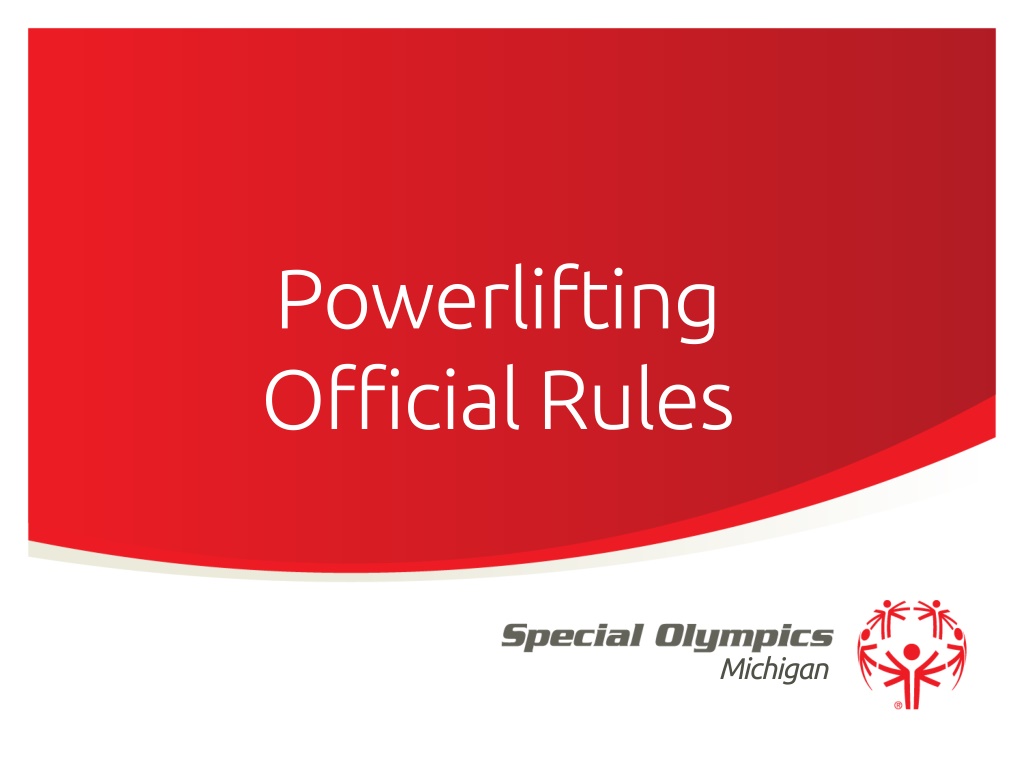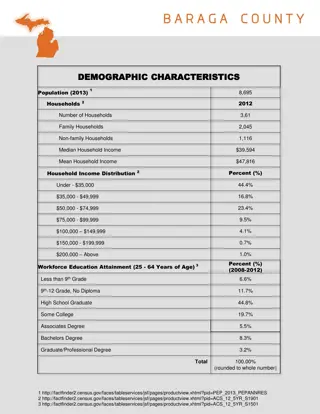Official Powerlifting Rules in Michigan
In Michigan, powerlifting competitions offer various events including squat, bench press, and deadlift. Competitors are required to wear a non-supportive, one-piece, form-fitting lifting suit made of fabric or synthetic material. The suit must have straps worn over the shoulders at all times and in all lifts. Specific regulations govern the material, design, and dimensions of the lifting suit, along with guidelines for footgear, knee wraps, wrist wraps, and belts. Jewelry, gloves, and supportive bench press shirts are prohibited during competitions.
Download Presentation

Please find below an Image/Link to download the presentation.
The content on the website is provided AS IS for your information and personal use only. It may not be sold, licensed, or shared on other websites without obtaining consent from the author.If you encounter any issues during the download, it is possible that the publisher has removed the file from their server.
You are allowed to download the files provided on this website for personal or commercial use, subject to the condition that they are used lawfully. All files are the property of their respective owners.
The content on the website is provided AS IS for your information and personal use only. It may not be sold, licensed, or shared on other websites without obtaining consent from the author.
E N D
Presentation Transcript
Powerlifting Official Rules Michigan
Events Offered Squat Bench Deadlift 2 Lift Combination (Bench & dead lift) 3 Lift Combination (Squat, Bench & Dead lift)
Uniform A non-supportive lifting suit shall be worn in competition. The suit straps must be worn over the lifter s shoulders at all times in all lifts in all competitions. The suit shall be one-piece and form fitting without any looseness when worn. The suit must be constructed entirely of fabric or a synthetic textile material, such that no support is given to the lifter by the suit in the execution of any lift. It may be of any color or colors.
Uniform The suit s material shall be of a single thickness, other than a second thickness of material of up to 12 cm x 24 cm allowed in the area of the crotch. There must be legs to the suit, extending a minimum of 3 cm and a maximum of 25 cm, from the top of the crotch down the inside of the leg, as measured when worn by the lifter in a standing position. Long pants may not be worn.. Supportive bench press shirts are prohibited. A T-shirt may be worn under the suit.
Uniform Footgear: Long socks (up to the knee) must be worn for the Deadlift. Sports type shoes e.g. trainer, powerlifting or weightlifting boots ONLY must be worn. No hiking or work boots allowed. Knee wrap: Wraps not exceeding 2 meters in length and 8 cm in width may be used. Hen worn, wraps should not be in contact with the socks or the lifting suit. Supportive wraps only IPF approved wraps shall be permitted for use in powerlifting competitions. Non supportive wraps: wraps made of medical crepe or bandage and sweatbands do not require IPF approval.
Uniform Wraps: wrist wraps of a maximum width of 8 centimeters and maximum length of 1 meter may be worn. A wrist wrap shall not extend beyond 10 centimeters above or 2 centimeters below the center of the wrist. In lieu of wrist wraps, wristbands not exceeding 10 centimeters in width may be worn. If wrist wraps are wrap around style, with or without stitching, to form a sleeve, they may have Velcro patches not exceeding 30 centimeters in total length and 8 centimeters in width as well as a thumb loop. The total length of a wristband shall not exceed 50 centimeters. The thumb loop shall not be over the thumb during competitive lift.
Uniform Belt: A belt made of leather, vinyl or similar nonstretch material may be worn on the outside of the suit. The belt dimensions should be not more than 4 inches at its greatest width and with a thickness not exceeding .5 inches. Belts should not have additional padding. No gloves are allowed Jewelry is prohibited. Wheelchair athletes may wear tight warm-up bottoms but not warm-up tops.
Uniform If a lifter, after the referee's inspection, changes part of his/her uniform, belt, or bandages, or puts on anything that has not been authorized or is contrary to the rules, he/she shall immediately be disqualified. No denim may be worn
Divisions Athletes shall be places in divisions according to sex, age, and weight. Age groups are 16-21 and 22+. Weight Classes Men 53 kg (116.5 lbs.) 59 kg (130 lbs.) 66 kg (145.5 lbs.) 74 kg (163 lbs.) 83 kg (183 lbs.) 93 kg (205 lbs.) 105 kg (231 lbs.) 120 kg (264.5 lbs.) 120+ kg (264.75+ lbs.) Weight Classes Women 43 kg (94.75 lbs.) 47 kg. (103 lbs.) 52 kg (114.5 lbs.) 57 kg (125.5 lbs.) 63 kg (139 lbs.) 69 kg (152 lbs.) 76 kg (167.5 lbs.) 84 kg (185 lbs.) 84+ kg (185.25+ lbs.)
Weigh-In Before trials and finals, the weigh-in of competitors must take place 1 hour and 15 minutes before the beginning of competition for a particular category. All the lifters in the category must attend the weigh-in, which shall be carried out in the presence of the three referees appointed for the category. Weigh-in will be in secret, and the lifters will be allowed in one at a time. The weigh-in room will be locked, and the persons allowed in the room are: the referees for the body weight classes, the lifter, and his coach or trainer. The weigh-in results will not be known until after the total weigh-in is finished.
Weigh-In Each competitor can only be weighed once. Only those greater or lighter than the category limit are allowed to return to the scales. They are allowed one hour at a maximum form the beginning of the weigh- in session to make the proper weight. After this time, they will be eliminated. When a lifter enters a weight class (for example the middleweight division of 165 lbs.), and for whatever reason fails to weigh as much as the lower limit of that class, he may drop into the lighter division if he has the sufficient qualifying total required in the particular weight class.
Weigh-In Lifters will be divided into flights of no more than fifteen lifters, which will be divided into divisions of no less than three and no more than eight lifters.
Competition Lifters will be divided into flights of no more than fifteen lifters, which will be divided into divisions of no less than three and no more than eight lifters. In each division, the lifter with the lightest attempt will lift first, and the weight loaded onto the bar will progressively increase until all lifters in the flight have lifted. The bar will then be unloaded, and second attempts will be performed in the same fashion, followed by third attempts.
General Rules Bar and Disc Specifications Distance between collars: 1m 31cm (4 3-1/2 ) at a maximum. Total length outside the sleeves: 2m 20cm (7 2-3/4 ) at a maximum. Diameter of the bar: 28mm (1-7/8 ) minimum; 29mm (1 1-3/16 ) maximum. Diameter of the largest disc: 45cm (1 5-3/4 ). Weight of the largest disc: 45kg (99 lbs) Weight of the largest bar and collars: 25kg (55 lbs)
General Rules The discs must be in the following range: 45kg (99 lbs), 25 kg (55 lbs), 20kg (44 lbs), 15kg (33 lbs), 10kg (22 lbs), 5kg (11 lbs), 2.5kg (5.5lbs), 1.25kg (2.5 lbs). Or 100 lbs., 45 lbs., 35 lbs., 25 lbs., 10 lbs., 5 lbs., 2.5 lbs., and 1.5 lbs. All discs must have a clear indication of their weight.
General Rules During any competition organized on a platform or stage, nobody other than the lifter, the members of the jury, the officiating referees, the managers, and the competing lifter s coach shall be allowed around the platform or on the stage. Before the beginning of competitions, the recognized officials must check the weight of the bar and discs so that the total weight may be identical with that announced. A lift must be declared NO LIFT and the lifter may be disqualified if the weights are dropped intentionally.
General Rules In no case can the weight be reduced when the lifter has attempted to perform a lift with the announced weight. Then the next flight will lift. Each competitor shall be allowed a period of two minutes from the calling of his/her name to the starting of the attempt. If the delay exceeds two minutes, the attempt shall be forfeited. The clock shall stop when the lifter starts the lift properly.
Scoring Scoring of the events shall be the maximum weight lifted for each event and a total combination maximum weight for both events. The Wilkes formula (WF) is present as a table of coefficients. Each lifter has a coefficient determined by body weight (BW). This is further explained in the Official Special Olympics Summer Sports Rules Book.
Bench Press The lifter must assume the following position on the bench and maintain this position during the lift: the head and trunk (including buttocks) must be extended on the bench, and the feet must be on the floor. The referee s signal shall be given when the bar is absolutely motionless at the chest. After the referee s signal, the bar is pressed vertically to straight arm s length and held motionless for the referee s signal to replace the bar.
Bench Press Athletes who are anatomically unable to fully lock out a bench press must have a certified coach state so at the weigh-in. A medical certificate should accompany the request. No changes in proper lifting techniques can be made for the lifter after weigh-in. The width of the bench shall not be less than 25 cm (9- 3/4 ) or more than 30cm (1 1-3/4 ). The height shall not be less than 35cm (1 3-3/4 ) and not more than 45cm (1 5-3/4 ). The length shall not be less than 1.22m (4 ), and the board shall be flat and level.
Bench Press The spacing of the hands shall not exceed 81cm (2 8 ), measured between the forefingers. For those lifters whose feet do not touch the floor, the platform may be built up with 20 kg. (45 lbs.) plates to provide firm footing. A maximum of four and a minimum of two spotter/loaders shall be mandatory; however, the lifter may enlist one or more of the official spotter/loaders to assist him/her in removing the bar form the racks.
Disqualification in Bench Press During the lift, any change of the lifting position. Any raising of shifting of the lifter s shoulders, buttocks or legs form the bench, or movement of the feet. Any heaving or bouncing of the bar from the chest. Allowing the bar to sink excessively into the chest prior to the uplift. Any uneven extension of the arms.
Disqualification in Bench Press Stopping of the bar during the press proper. Any touching of the bar by the spotter before the referee s signal to replace the bar. Failure to wait for the referee s signal. Touching against the uprights of the bench with the feet. Touching the shoulders against the uprights of the bench during the bench press. Allowing the bar to touch the uprights of the bench during the lift in order to gain an advantage.
Dead Lift The bar must be laid horizontally in front of the lifter s feet, gripped with both hands, and uplifted with one continuous motion until the lifter is standing erect. At competition of the lift, the knees must be locked and the shoulders thrust back. The referee s signals shall indicate the time when the bar is held motionless in the final position. The lifter shall face the front of the platform.
Dead Lift Any rising of the bar or any deliberate attempt to do so shall count as an attempt. On completion of the lift, the knees shall be locked in the straight position, and they should be held in an erect position (not forward or rounded). The shoulders do not have to be thrust back past an erect position; however, if they are thrust back in that manner, and all other criteria is acceptable, the lift shall be accepted.
Disqualification in Dead Lift Any stopping of the bar before it reaches final position. Failure to stand erect. Failure to lock the knees. Supporting the bar on the thighs. Any shifting of the feet during the performance of the lift.
Disqualification in Dead Lift The toes or heels may be raised provided that either foot is not displaced or comes down in a different position. Lowering the bar before the referee s signal to do so. Allowing the bar to return to the platform without maintaining control with both hands.
Squat The lifter shall assume an upright position with the top of the bar not more than 3 cm below the top surface of the anterior deltoids. The bar shall be held horizontally across the shoulders with the hands and fingers gripping the bar (not the collars) and the feet flat on the platform with the knees locked. http://bloximages.chicago2.vip.townnews.com/journalstar.com/content/tncms/assets/v3/editorial/8/47/8470f3b0-9360-11df-a122-001cc4c002e0/4c44946d47ad9.image.jpg
Squat After removing the bar from the racks, the lifters must move backwards to establish their position. The lifter shall wait in this position for the chief referee s signal. The signal shall be given as soon as the lifter is motionless and the bar properly positioned. If mechanical racks that withdraw are used, the lifter must remove the barbell form the racks before they are withdrawn and wait motionless for the chief referee s signal. The signal shall consist of a downward movement of the arm and an audible command to squat .
Squat Upon receiving the chief referee s signal, the lifter must bend and lower the body until the top surface of the legs at the hip joint is lower than the top of the knees. The lifter must recover at will without double bouncing or any downward movement after starting up to an upright position with the knees locked. When the lifter is motionless, the chief referee will give the signal to replace to bar.
Squat The signal to replace the bar will consist of a backward motion for the hand and an audible command to rack . The lifter must then make a bona fide attempt to return the bar to the racks. The lifter shall face the front of the platform. Upon receiving the chief referee s signal, the lifter must bend and lower the body until the top surface of the legs at the hip joint is lower than the top of the knees.
Squat The lifter must recover at will without double bouncing or any downward movement after starting up to an upright position with the knees locked. When the lifter is motionless, the chief referee will give the signal to replace to bar. The signal to replace the bar will consist of a backward motion for the hand and an audible command to rack . The lifter must then make a bona fide attempt to return the bar to the racks. The lifter shall face the front of the platform.
Squat The lifter shall not hold the collars, sleeves, or discs at any time during the performance of the lift. However, at the edge of the hand gripping, the bar may be in contact with the inner surface of the collars. The lifter may enlist the help of the spotter/loaders in removing the bar and replacing it in the racks; however, once the bar has cleared the racks, spotter/loaders shall not assist the lifter further with regard to proper positioning, foot placement, bar positioning, etc.
Disqualification in Squat Failure to wait for the signals form the head referee ( squat and rack ). Any shift of feet after referee gives the signal to squat and before the signal to rack. Any touching of the bar by spotters before the referee s signal to replace the bar to the rack. Any movement or repositioning of the bar on the lifter s back after receiving the signal to squat.
Atlantoaxial Instability Rule Athletes with Downs Syndrome must have an x-ray indicating that he/she does not have atlantoaxial instability prior to participation in the power lifting squat event.
Terms Adaptation: Body/muscle adjust to increased workload or training stress Ascent: Raising of the bar in any lift Commands: Referees instructions prior to, during and after lifts, as per the International Powerlifting Federation Rules Descent: Lowering the bar in any lift Erect Position: Standing upright, legs locked
Terms Hitching: Excessive supporting of the bar on the legs during the dead lift, usually as a ratcheting motion up the leg Leverage: The mechanical advantage or disadvantage applied during the lift by the position of the body part based upon hand placements, foot placement, or joint positioning
Terms Muscle Endurance: Ability of muscle to produce work for a relatively long period of time Overcompensation: Tendency of body to elevate performance capability as a response to workload or increased training stress Overload: Workload exceeds that previously experienced
Terms Negatives: Exercises that focus most of the energy of the lift toward the extension of the muscle and not the contraction. An example is allowing the lifter to lift the bar in the bench press from extended position to the chest and then have spotter assist to extension. Negatives can result in soreness and injury and shouldn t be avoided Parallel: The point in the squat where the lifter s hip joint is even with the knee joint. To perform an acceptable lift, the lifter must go
Terms Parallel: The point in the squat where the lifter s hip joint is even with the knee joint. To perform an acceptable lift, the lifter must go lower that parallel Peaking: Training at 90 percent or higher, usually only in the last three to four weeks prior to competition Periodization: Change in volume and intensity of workload overtime
Terms Power: Strength with speed Primary lifts: Squat, bench press, and deadlift or exercises that are basically irreplaceable for their contribution to overall strength development Primary muscles: Largest muscles capable of producing the most work in the squat, bench press, and deadlift or that contribute to overall strength development
Terms Recuperation: Muscles return to normal state or homeostasis Repetitions: Number of consecutive movements in an exercise between rest periods Secondary lifts: all supplementary lifts other than the squat, bench press, and deadlift or that directly contribute to overall strength development
Terms Secondary Muscles: Smaller muscles that contribute to the work produced by the primary muscles directly or help with balance or control Sets: Number of times a group of repetitions is performed Strength: Ability of muscle to produce force Top Set: Heaviest set
Terms Spotting: The process of closely following the movement of the athlete during the lift with hands ready to assist if necessary. Except for during the learning period or for assisting when the athlete appears unable to make the lift, the hands should not be placed upon the bar or the athlete s body
Terms Wilks Formula: Formulas that use historically based numbers by which different body weights can be reconciled or leveled to compare lifting competition results

























